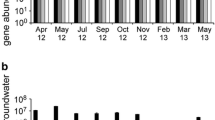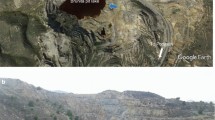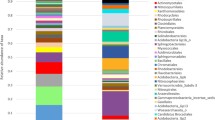Abstract
The microbial diversity in two deep, confined aquifers, the Grande Ronde (1270 m) and the Priest Rapids (316 m), Hanford Reservation, Washington, USA, was investigated by sampling from artesian wells. These basaltic aquifers were alkaline (pH 8.5 to 10.5) and anaerobic (Eh −200 to −450 mV). The wells were allowed to free-flow until pH and Eh stabilized, then the microflora was sampled with water filtration and flow-through sandtrap methods. Direct microscopic counts showed 7.6 × 105 and 3.6 × 103 bacteria ml−1 in water from the Grande Ronde and Priest Rapids aquifers, respectively. The sand filter method yielded 5.7 × 108 and 1.1 × 105 cells g−1 wet weight of sand. The numbers of bacteria did not decrease as increasing volumes of water were flushed out. The heterotrophic diversity of these bacterial populations was assessed using enrichments for 20 functional groups. These groups were defined by their ability to grow in a matrix of five different electron acceptors (O2, Fe(III), NO3 −, SO4 2−, HCO3 −) and four groups of electron donors (fermentation products, monomers, polymers, aromatics) in a mineral salts medium at pH 9.5. Growth was assessed by protein production. Culture media were subsequently analyzed to determine substrate utilization patterns. Substrate utilization patterns proved to be more reliable indicators of the presence of a particular physiological group than was protein production. The sand-trap method obtained a greater diversity of bacteria than did water filtration, presumably by enriching the proportion of normally sessile bacteria relative to planktonic bacteria. Substrate utilization patterns were different for microflora from the two aquifers and corresponded to their different geochemistries. Activities in the filtered water enrichments more closely matched those predicted by aquifer geochemistry than did the sand-trap enrichments. The greatest activities were found in Fe(III)-reducing enrichments from both wells, SO4-reducing enrichments from the Grande Ronde aquifer, and methanogenic enrichments from the Priest Rapids aquifer. Organisms from these aquifers may be useful for high-pH bioremediation applications as well as production of biotechnological products. These organisms may also be useful for modeling potential reactions near buried concrete, as might be found in subsurface waste depositories.
Similar content being viewed by others
References
Balkwill DL (1989) Numbers, diversity, and morphological characteristics of aerobic, chemoheterotrophic bacteria in deep subsurface sediments from a site in South Carolina. Geomicrobiol J 7:33–52
Bath AH, Christofi N, Neal C, Philp JC, Cave MR, McKinley IG, Berner U (1987) Trace element and microbiological studies of alkaline groundwaters in Oman, Arabian Gulf: A natural analogue for cement pore-waters. Rep Fluid Processes Res Group Br Geol Surv FLPU 87-2
Early TO, Spice GD, Mitchell MD (1986) Hydrochemical database for the Hanford Site, Washington. Basalt Waste Isolation Project Document Number B WI-DP-061, Rockwell Hanford Operations, Richland, Washington
Francis AJ, Slater JM, Dodge CJ (1989). Denitrification in deep subsurface sediments. Geomicrobiol J 7:103–116
Fredrickson JK, Garland TR, Hicks RJ, Thomas JM, Li SW, McFadden KM (1989) Lithotrophic and heterotrophic bacteria in deep subsurface sediments and their relation to sediment properties. Geomicrobiol J 7:53–66
Ghiorse WC (1988) Microbial reduction of manganese and iron. In: Zehnder AJB (ed) Biology of anaerobic microorganisms. John Wiley & Sons, New York, pp 305–331
Grant WD, Mwatha WE, Jones BE (1990) Alkaliphiles: Ecology, diversity and applications. FEMS Microbiol Rev 75:255–270
Hoefs J (1980) Stable isotope geochemistry. Springer-Verlag, New York
Jones RE, Beeman RE, Suflita JM (1989) Anaerobic metabolic processes in the deep terrestrial subsurface. Geomicrobiol J 7:117–130
Lovley DR, Goodwin S (1988) Hydrogen concentrations as an indicator of the predominant terminal electron-accepting reactions in aquatic sediments. Geochimica et Cosmochimica Acta 52:2993–3003
Lovley DR, Baedecker MJ, Longergan DJ, Cozzarelli IM, Phillips EJP, Siegel DI (1989) Oxidation of aromatic contaminants coupled to microbial iron reduction. Nature 339:297–299
Lovley DR, Chapelle FH, Phillips EJP (1990) Fe(III)-reducing bacteria in deeply buried sediments of the Atlantic coastal plain. Geology 18:954–957
Lovley DR, Phillips EJP, Gorby YA, Landa ER (1991) Microbial reduction of uranium. Nature 350:413–416
Madsen EL, Bollag J-M (1989) Aerobic and anaerobic microbial activity in deep subsurface sediments from the Savannah River Plant. Geomicrobiol 17:93–101
Marxsen J (1988) Investigations into the number of respiring bacteria in groundwater from sandy and gravelly deposits. Microb Ecol 16:65–72
McMahon PB, Williams DF, Morris JT (1990) Production and carbon isotopic composition of bacterial CO2 in deep coastal plain sediments of South Carolina. Ground Water 28:693–702
Olson RV, Ellis R Jr (1982) Iron, In: Page AL, Miller RH, Keeney DR (eds) Methods of soil analysis. Part 2. Chemical and microbiological properties. 2nd ed. Am Soc Agron, Inc, Madison, WI, pp 301–312
Oremland RS (1988) Biogeochemistry of methanogenic bacteria. In Zehnder AJB (ed) Biology of anaerobic microorganisms. John Wiley & Sons, New York, pp 641–705
Pedersen K, Ekendahl S (1990) Distribution and activity of bacteria in deep granitic groundwaters of southeastern Sweden. Microb Ecol 20:37–52
Phelps TJ, Raione EG, White DC, Fliermans CB (1989) Microbial activities in deep subsurface environments. Geomicrobiol J 7:79–91
Sinclair JL, Ghiorse WC (1989) Distribution of aerobic bacteria, protozoa, algae, and fungi in deep subsurface sediments. Geomicrobiol J 7:15–31
US Department of Energy (1988) Consultation draft, site characterization plan, reference repository location, Hanford Site, Washington. DOE/RW-0164 vol 1–3
West JM, Christofi N, McKinley IG (1985) An overview of recent microbiological research relevant to the geological disposal of nuclear waste. Radioact Waste Manage Nucl Fuel Cycle 6:79–95
White AF, Yee A (1985) Aqueous oxidation-reduction kinetics associated with coupled electron-cation transfer from iron-containing silicates at 25°C. Geochimica et Cosmochimica Acta 49: 1263–1275
Author information
Authors and Affiliations
Additional information
Offprint requests to: T. O. Stevens.
Rights and permissions
About this article
Cite this article
Stevens, T.O., McKinley, J.P. & Fredrickson, J.K. Bacteria associated with deep, alkaline, anaerobic groundwaters in Southeast Washington. Microb Ecol 25, 35–50 (1993). https://doi.org/10.1007/BF00182128
Received:
Revised:
Issue Date:
DOI: https://doi.org/10.1007/BF00182128




